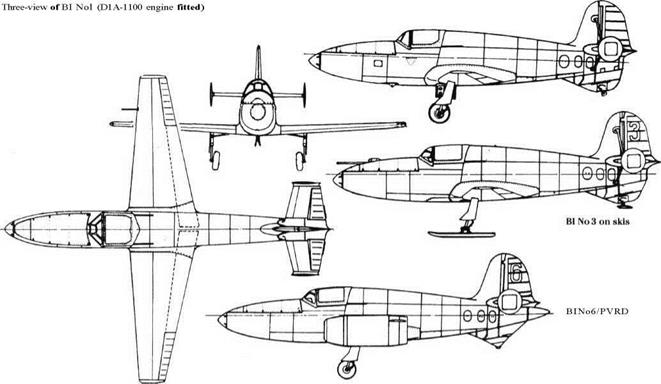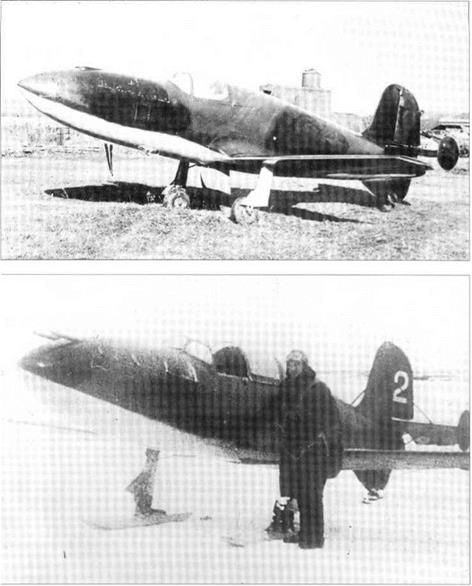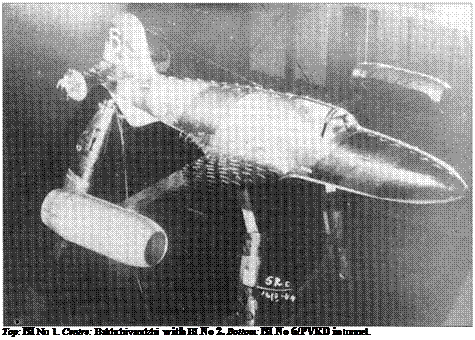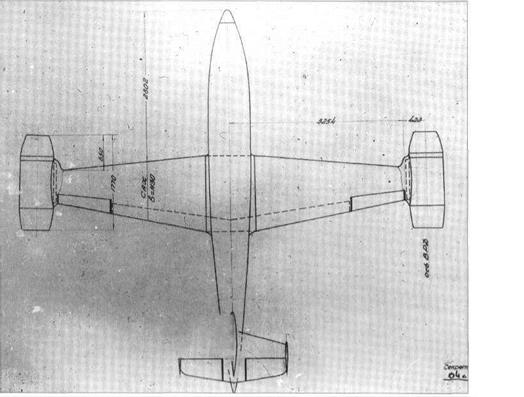Bereznyak-Isayev BI
 |
Purpose: Experimental rocket-engined interceptor-fighter.
Design Bureau: Designers Aleksandr Yakovlevich Bereznyak and Aleksei Mikhailovich Isayev, working at OKB of Bolkhovitinov, later managed by CAHI (TsAGI).
In 1939 Bereznyak was an observer at the static tests of the first reliable rocket engine developed by Leonid Stepanovich Dushkin. In early 1940 he watched flight tests of the primitive RP-318 (see later under Korolyev). He discussed rocket aircraft with Isayev, who had been a Dushkin engineer involved with the RP-318. In late May 1941 they decided to propose a high-speed rocket-engined fighter. They put the suggestion to Prof Bolkhovitinov (see later entry). After discussion with all interested parties Bolkhovitinov sent a letter to GUAP (chief administration ofaviation industry) on 9th July 1941 putting forward a detailed proposal. Soon a reply came from the Kremlin. The principals were called to GUAP before Shakhurin and A S Yakovlev, and within a week there was a full go-ahead. The order was for five prototypes, with the time to first flight cut from the suggested three months to a mere 35 days.
A complete Bolkhovitinov team were confined to the OKB for 40 days, working three shifts round the clock. Tunnel testing was
done at CAHI, supervised by G S Byushgens. The first (unpowered) flight article was built without many drawings, dimensions being drawn directly on the materials and on templates. B M Kudrin made the first flight on 10 th September 1941, the tug being a Pe-2. All necessary data were obtained in 15 flights. On 16th October the OKB and factory was evacuated to a half-built shed outside Sverdlovsk. The first (experimental) D-1A engine was installed in late January 1942, but exploded during testing on 20th February, injuring Kudrin (sent to hospital in Moscow) and a technician. The replacement pilot was Capt G Ya Bakhshivandzhi. He was in the cockpit on the first tied-down firing on 27th April 1942. On 15th May 1942 he made the world’s first flight of a fully engineered rocket interceptor, still fitted with skis.
By March 1943 seven BI prototypes had been constructed, but the flying was entirely in towed or gliding flight because of serious problems caused by explosions and acid spillages. Powered flying did not resume until February 1943. By this time Kudrin had returned to flight status, and was assigned one of the Bis. On powered flight No 6 on 21st March 1943 a height of 3km (9,843ft) was reached in 30 seconds. On powered flight No7, with aircraft No 3, on 27th March, Bakhshivandzhi made a run at sustained full power; the aircraft suddenly pitched over and
dived into the ground. Tunnel testing later showed that at about 900km/h the BI would develop a nose-down pitching moment which could not be held by the pilot.
|
Dimensions |
||
|
Span |
||
|
Nosland2 |
6.48m |
21 ft 3 in |
|
Nos 3 and later |
6.6 m |
21 ft 8 in |
|
Length |
||
|
Nos 1 and 2 |
6.4 m |
21ft |
|
Nos 3 and later |
6.935 m |
22 ft 9 in |
|
Wing area |
||
|
Nos land 2 |
7.0m2 |
75.3ft2 |
|
No 3 |
7.2m2 |
77.5ft2 |
|
Weights Empty |
||
|
Nol |
462 kg |
1,019 Ib |
|
No 3 |
790kg |
1,742Ib |
|
No 7 |
805kg |
l,7751b |
|
Loaded |
||
|
No 3 |
1,650kg |
3,638 Ib |
|
No 7 |
1,683kg |
3,710 Ib |
|
Performance |
||
|
Maximum speed |
||
|
original estimate |
800 km/h |
497 mph |
|
achieved |
900 km/h |
559 mph |
|
1943 high-altitude estimate, not attempted |
1,020 km/h |
634 mph |
|
Time to accelerate from 800 to 900 km/h |
20 seconds |
|
|
Take-off run |
400m |
1,310ft |
|
Initial climb |
120m/s |
23,622 ft/min |
|
Time to 5,000 m |
50 seconds |
16,404ft |
|
Endurance under full power |
2 min |
|
|
Landing speed |
143 km/h |
89 mph |

 This terminated the delayed plan to build a production series of 50 slightly improved aircraft, but testing of the prototypes continued. Until the end of the War these tested various later Dushkin engines, some with large thrust chambers for take-off and combat and small chambers to prolong the very short cruise endurance (which was the factor resulting in progressive waning of interest). Other testing attempted to perfect a sealed pressurized cockpit. To extend duration significantly BI No 6 was fitted with a Merkulov DM-4 ramjet on each wingtip. These were fired during test in the CAHI T-101 wind tunnel, but not in flight.
This terminated the delayed plan to build a production series of 50 slightly improved aircraft, but testing of the prototypes continued. Until the end of the War these tested various later Dushkin engines, some with large thrust chambers for take-off and combat and small chambers to prolong the very short cruise endurance (which was the factor resulting in progressive waning of interest). Other testing attempted to perfect a sealed pressurized cockpit. To extend duration significantly BI No 6 was fitted with a Merkulov DM-4 ramjet on each wingtip. These were fired during test in the CAHI T-101 wind tunnel, but not in flight.
By 1944 the urgency had departed from the programme, and the remaining BI Nol (some were scrapped following acid corrosion) were used as basic research aircraft. BI No7 was modified with revised wing-root fairings and stronger engine cowl panels, but at high speed tailplane flutter was experienced. BI No 5s (on skis) and BI No 6 (on wheels) were modified and subjected to investigative gliding tests, initially towed by a B-25J.
In 1948 Bereznyak proposed a mixed – power interceptor with a three-chamber rocket engine of 10,000kg (22,046 Ib) sea – level thrust, for ‘dash’ performance, and a Mikulin AM-5 turbojet of 1,900kg (4,1891b) sea-level thrust. Estimated maximum speed was Mach 1.8, and range 750km (466 miles). This was not proceeded with.
The BI Nol had a small and outstandingly simple all-wood airframe. The straight-tapered wing, 6 per cent thick, had two box spars and multiple stringers supporting skin mainly of 2mm ply. Outboard were fabric – covered ailerons. Inboard were split flaps with light-alloy structure (the only major metal parts), with a landing angle of 50°. The fuselage was a plywood monocoque with fabric bonded over the outer surface. It was constructed integral with the upper and lower fins. The rudder and elevators were fabric-covered. On the tailplane were added small circular endplate fins, and the powered aircraft had the tailplane braced to both the upper and lower fins.
The engine bay was lined with refractory materials and stainless steel. The standard engine was the Dushkin D-1A-1100, the designation reflecting the sea-level thrust (2,425 Ib), rising to about 1,300kg (2,866 Ib) at high altitude. The propellants, fed by compressed air, were RFNA (red fuming nitric acid) and kerosene. These were contained in cylindrical stainless-steel tanks in the centre fuselage. The pneumatic system not only fed the propellants but also charged the guns and operated the flaps and main landing gears. The latter retracted inwards into the wings and normally had wheels with 500 x 150 tyres. Under the ventral fin was a retracting tail-
wheel. In winter these units were replaced by skis, the main skis retracting to lie snugly under the wings.
The cockpit had a simple aft-sliding canopy, and a bulletproof windscreen. Certain of the prototypes had armament, comprising two ShVAK 20mm cannon, each with 45 rounds, fired electrically and installed in
the upper half of the nose under a cover secured by three latches on each side. Between the spars under the propellant cylinders was a bay which in some aircraft could house a small bomb load (see below). Structural factor of safety was 9, rising to no less than 13.5 after using most of the propellants.
By any yardstick the BI No 1 was a remark
able achievement, and all pilots who flew it thought it handled beautifully. It was killed by the time it took to overcome the problems, and – crucially – by the impracticably short flight endurance.
|
The nominal weight breakdown for a fully equipped powered aircraft was:
|

|
ri |
|||
|
Iі |
! |
||
OKB drawing of BI No 6/PVRD.










